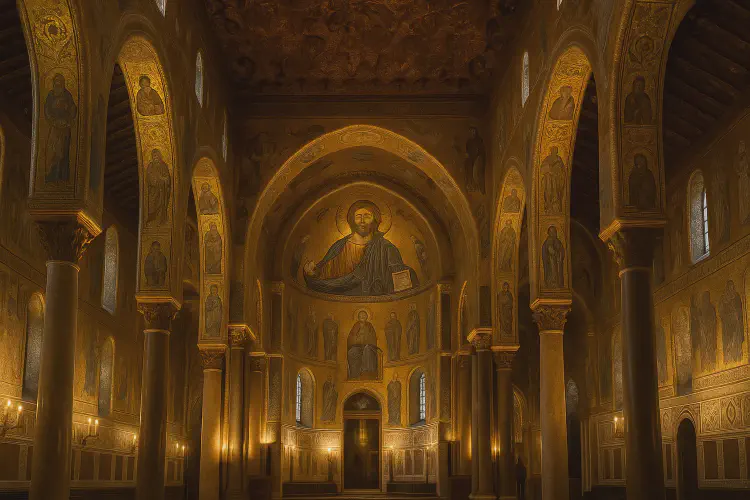Cultural Sicily itinerary
Sicily’s culture is a mosaic of civilizations — Greek, Roman, Arab, Norman, and Baroque — each leaving a lasting mark on its cities, temples, and cuisine. This **Cultural Sicily itinerary** takes you through the island’s most artistic and historical highlights, blending museums, architecture, and local traditions in a journey through time.
- Visit Sicily
- 3 min read

Cultural Sicily Itinerary — Temples, Mosaics, and Timeless Traditions
🧭 Overview
This 8-day itinerary is ideal for travelers fascinated by history, art, and architecture. It follows a cultural arc from Palermo’s Norman mosaics to Agrigento’s Greek temples, ending with Baroque splendor in Noto and Syracuse. Each stop reveals a layer of Sicily’s unique cultural identity — where East meets West, and past meets present.
🗓️ Day 1: Palermo — Arab-Norman Heritage
- Explore: Palermo Cathedral, Palatine Chapel, and Norman Palace (UNESCO-listed).
- Walk through: Quattro Canti and Piazza Pretoria for Baroque facades.
- Visit: The Teatro Massimo — Italy’s largest opera house.
- Eat: Street food at Ballarò Market — arancine, panelle, and sfincione.
🗓️ Day 2: Monreale & Cefalù — Golden Mosaics and Coastal Beauty
- Morning: Short trip to Monreale Cathedral — covered in 6,000 m² of Byzantine mosaics.
- Afternoon: Continue to Cefalù, a Norman town by the sea.
- Highlights:
- Cefalù Cathedral (UNESCO site).
- Medieval washhouse and old harbor.
- Evening stroll along the beach promenade.
🗓️ Day 3: Segesta & Selinunte — Greek Grandeur
- Drive: 1.5 hrs to Segesta; explore the ancient Doric temple and hillside theatre.
- Continue to: Selinunte Archaeological Park, one of Europe’s largest Greek ruins.
- Stay overnight: in nearby Castelvetrano or Marsala.
🗓️ Day 4: Agrigento — Valley of the Temples
- Morning: Drive to Agrigento, home of the iconic Valley of the Temples (UNESCO site).
- Highlights:
- Temple of Concordia, one of the best-preserved Doric temples in the world.
- Temple of Hera and Temple of Heracles.
- Archaeological Museum with artifacts from ancient Akragas.
- Evening: Stroll through the historic old town and enjoy pasta alla Norma.
🗓️ Day 5: Piazza Armerina — Roman Mosaics & Central Sicily
- Visit: Villa Romana del Casale, famous for its 4th-century mosaics including the “Bikini Girls.”
- Learn about: Roman luxury and daily life through its detailed floor art.
- Stay overnight: in Enna or Caltagirone.
🗓️ Day 6: Catania — Baroque Revival and Local Life
- Explore: Piazza Duomo with the Elephant Fountain and Cathedral of Sant’Agata.
- Visit: Benedictine Monastery of San Nicolò l’Arena — a Baroque masterpiece.
- Optional: Evening stroll along Via Crociferi, lined with ornate churches.
- Eat: Pasta con le sarde and cannolo siciliano at a traditional trattoria.
🗓️ Day 7: Syracuse — Ancient Splendor by the Sea
- Morning: Neapolis Archaeological Park — Greek Theatre, Roman Amphitheatre, and Ear of Dionysius.
- Afternoon: Cross to Ortigia Island, visit the Cathedral built over a Greek temple.
- Evening: Watch sunset at the Aretusa Fountain and dine by the water.
🗓️ Day 8: Noto — The Baroque Jewel
- Drive: 40 minutes from Syracuse.
- Explore:
- Noto Cathedral and Palazzo Nicolaci.
- Baroque balconies, churches, and honey-colored stone facades.
- Visit a local café for granita al mandorla (almond granita).
- Optional: Visit nearby beaches or vineyards before returning to Catania or Palermo.
🚗 Travel Logistics
- Best starting point: Palermo (arrive) and Catania (depart).
- Transport: Car rental recommended for flexibility.
- Duration: 8 days minimum; extend to 10–12 for a slower pace.
- Ideal seasons: Spring and autumn for comfortable sightseeing weather.
💡 Tips
- Purchase the Archaeological Park Pass for discounted entry to temples and sites.
- Consider guided tours in Palermo, Agrigento, and Syracuse for deeper context.
- Dress modestly when visiting religious sites.
🌅 Summary
This cultural itinerary captures Sicily’s timeless legacy — from Greek temples and Roman mosaics to Norman cathedrals and Baroque towns. It’s a journey through the layers of Mediterranean history that shaped the island’s identity, art, and soul. By the end, you’ll understand why Sicily is not just part of Italy — it’s a civilization unto itself.